CPCCBC5005A Assessment 4: Subcontractor Management Report
VerifiedAdded on 2023/06/03
|20
|5190
|457
Report
AI Summary
This report is an assessment of subcontractor selection and management within the context of the Strathfield Apartment project. Part 2 focuses on evaluating and comparing budget estimates from four potential subcontractors (Ultimate Concrete Services Pty Ltd, Professional Formwork and Concreting Services Pty Ltd, Quality Concreting Pty Ltd, and P&W Concreting Services Pty Ltd) for formwork and concrete works, ultimately recommending P&W Concreting Services Pty Ltd. Part 3 delves into the processes of managing subcontractors, including a pre-award interview template, criteria for selecting new subcontractors, subcontractor communication strategies, performance management techniques (including addressing poor performance), and site induction procedures. The report emphasizes the importance of selecting the right subcontractor based on cost, time, and the ability to complete the required works. The report also includes detailed tables comparing the budget estimates of each subcontractor.
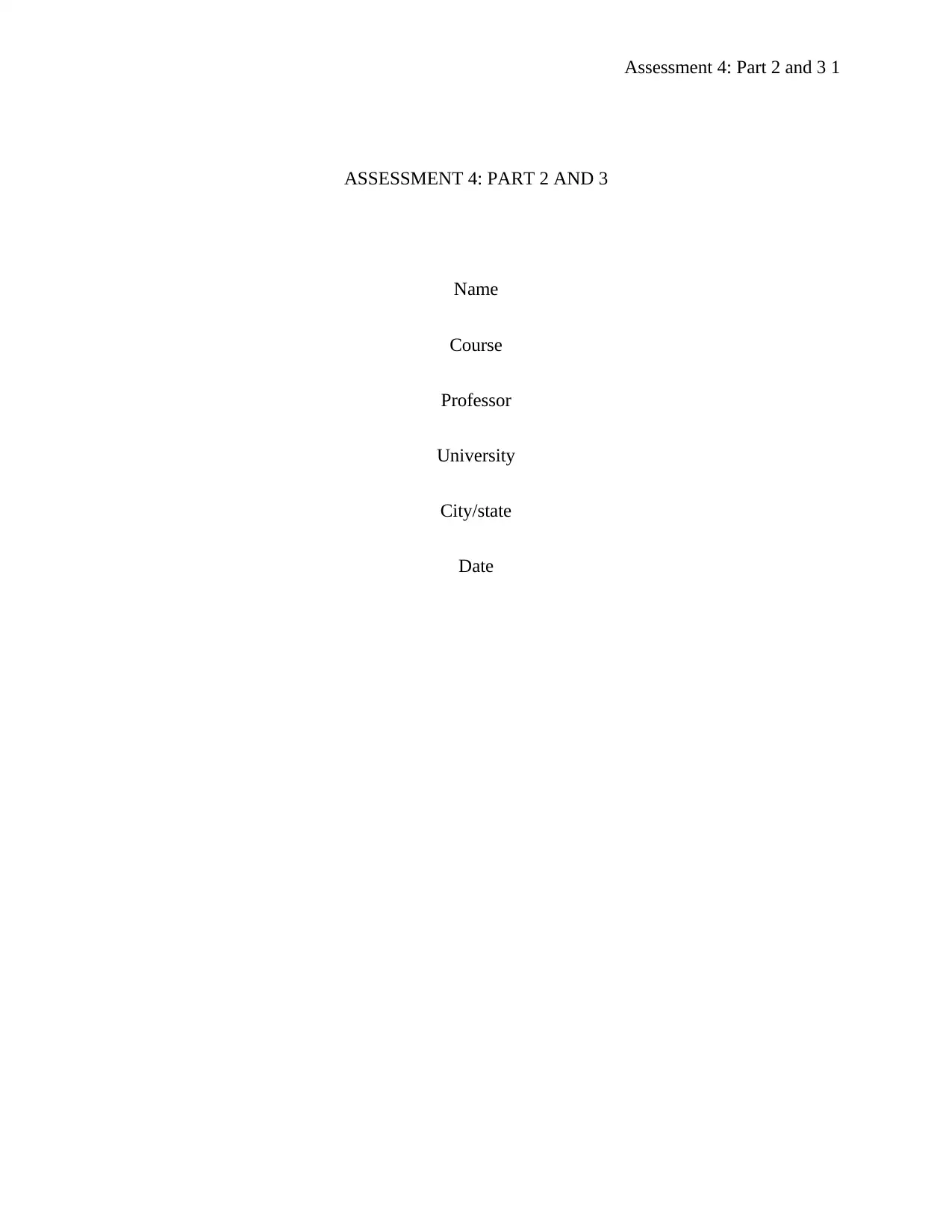
Assessment 4: Part 2 and 3 1
ASSESSMENT 4: PART 2 AND 3
Name
Course
Professor
University
City/state
Date
ASSESSMENT 4: PART 2 AND 3
Name
Course
Professor
University
City/state
Date
Paraphrase This Document
Need a fresh take? Get an instant paraphrase of this document with our AI Paraphraser
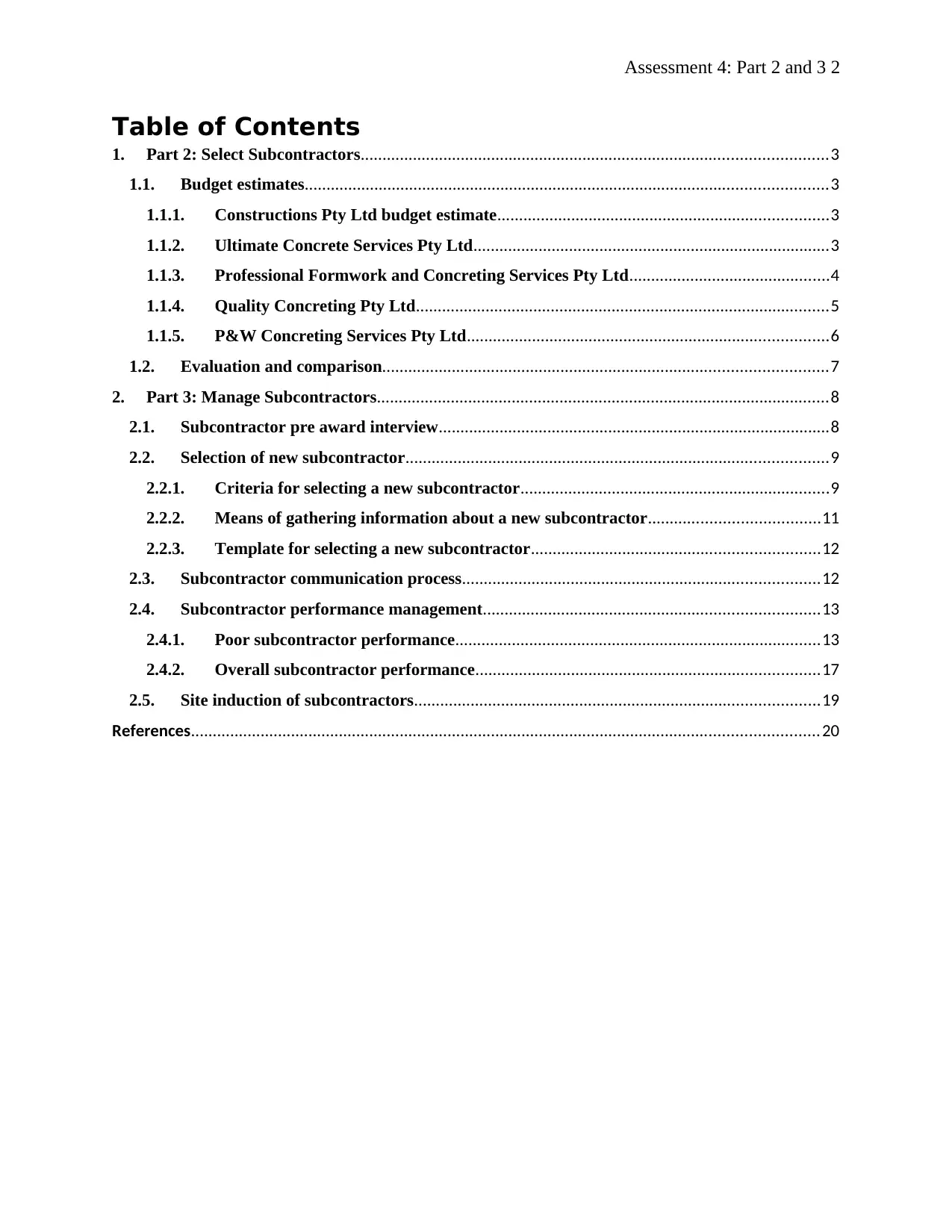
Assessment 4: Part 2 and 3 2
Table of Contents
1. Part 2: Select Subcontractors...........................................................................................................3
1.1. Budget estimates........................................................................................................................3
1.1.1. Constructions Pty Ltd budget estimate............................................................................3
1.1.2. Ultimate Concrete Services Pty Ltd..................................................................................3
1.1.3. Professional Formwork and Concreting Services Pty Ltd..............................................4
1.1.4. Quality Concreting Pty Ltd...............................................................................................5
1.1.5. P&W Concreting Services Pty Ltd...................................................................................6
1.2. Evaluation and comparison......................................................................................................7
2. Part 3: Manage Subcontractors........................................................................................................8
2.1. Subcontractor pre award interview..........................................................................................8
2.2. Selection of new subcontractor.................................................................................................9
2.2.1. Criteria for selecting a new subcontractor.......................................................................9
2.2.2. Means of gathering information about a new subcontractor.......................................11
2.2.3. Template for selecting a new subcontractor..................................................................12
2.3. Subcontractor communication process..................................................................................12
2.4. Subcontractor performance management.............................................................................13
2.4.1. Poor subcontractor performance....................................................................................13
2.4.2. Overall subcontractor performance...............................................................................17
2.5. Site induction of subcontractors.............................................................................................19
References................................................................................................................................................20
Table of Contents
1. Part 2: Select Subcontractors...........................................................................................................3
1.1. Budget estimates........................................................................................................................3
1.1.1. Constructions Pty Ltd budget estimate............................................................................3
1.1.2. Ultimate Concrete Services Pty Ltd..................................................................................3
1.1.3. Professional Formwork and Concreting Services Pty Ltd..............................................4
1.1.4. Quality Concreting Pty Ltd...............................................................................................5
1.1.5. P&W Concreting Services Pty Ltd...................................................................................6
1.2. Evaluation and comparison......................................................................................................7
2. Part 3: Manage Subcontractors........................................................................................................8
2.1. Subcontractor pre award interview..........................................................................................8
2.2. Selection of new subcontractor.................................................................................................9
2.2.1. Criteria for selecting a new subcontractor.......................................................................9
2.2.2. Means of gathering information about a new subcontractor.......................................11
2.2.3. Template for selecting a new subcontractor..................................................................12
2.3. Subcontractor communication process..................................................................................12
2.4. Subcontractor performance management.............................................................................13
2.4.1. Poor subcontractor performance....................................................................................13
2.4.2. Overall subcontractor performance...............................................................................17
2.5. Site induction of subcontractors.............................................................................................19
References................................................................................................................................................20
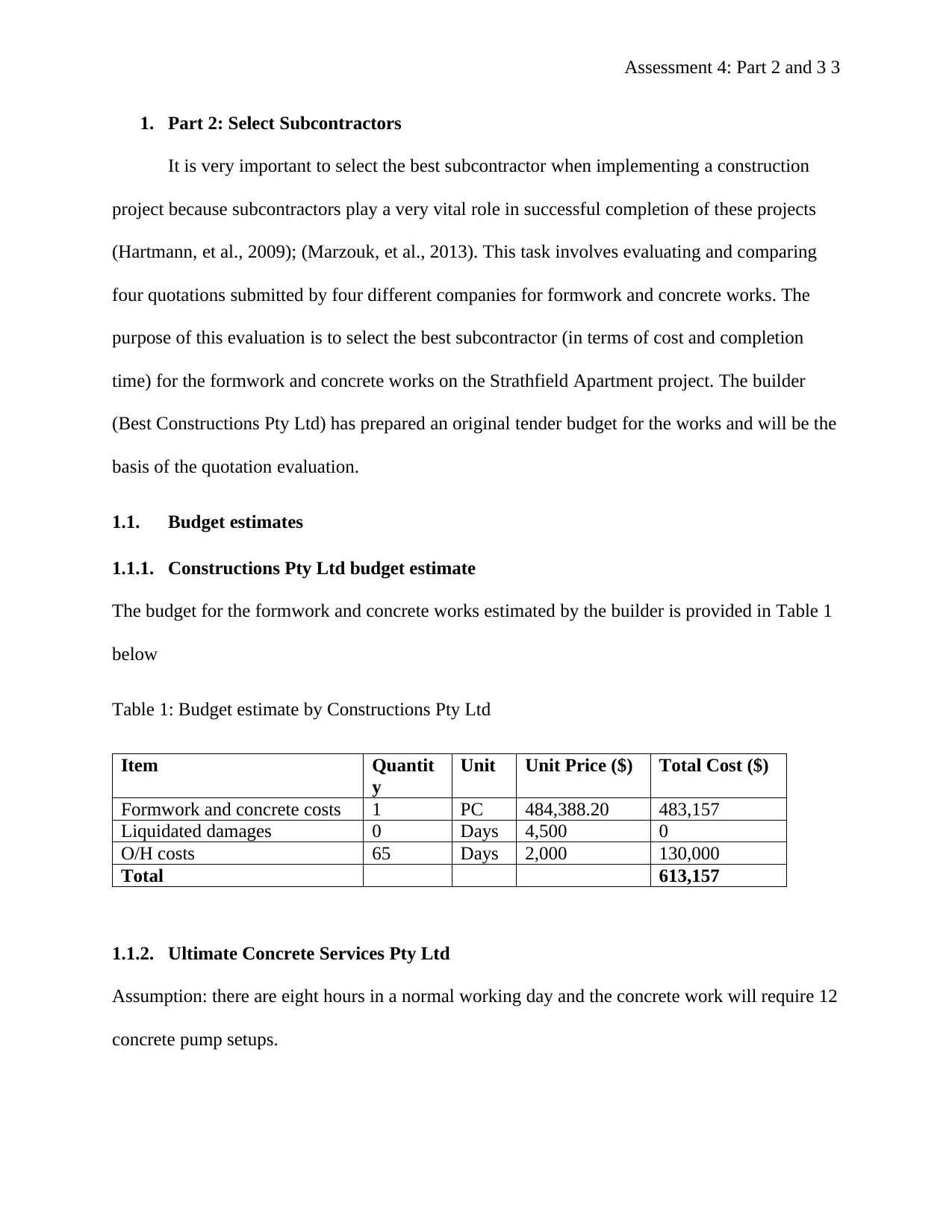
Assessment 4: Part 2 and 3 3
1. Part 2: Select Subcontractors
It is very important to select the best subcontractor when implementing a construction
project because subcontractors play a very vital role in successful completion of these projects
(Hartmann, et al., 2009); (Marzouk, et al., 2013). This task involves evaluating and comparing
four quotations submitted by four different companies for formwork and concrete works. The
purpose of this evaluation is to select the best subcontractor (in terms of cost and completion
time) for the formwork and concrete works on the Strathfield Apartment project. The builder
(Best Constructions Pty Ltd) has prepared an original tender budget for the works and will be the
basis of the quotation evaluation.
1.1. Budget estimates
1.1.1. Constructions Pty Ltd budget estimate
The budget for the formwork and concrete works estimated by the builder is provided in Table 1
below
Table 1: Budget estimate by Constructions Pty Ltd
Item Quantit
y
Unit Unit Price ($) Total Cost ($)
Formwork and concrete costs 1 PC 484,388.20 483,157
Liquidated damages 0 Days 4,500 0
O/H costs 65 Days 2,000 130,000
Total 613,157
1.1.2. Ultimate Concrete Services Pty Ltd
Assumption: there are eight hours in a normal working day and the concrete work will require 12
concrete pump setups.
1. Part 2: Select Subcontractors
It is very important to select the best subcontractor when implementing a construction
project because subcontractors play a very vital role in successful completion of these projects
(Hartmann, et al., 2009); (Marzouk, et al., 2013). This task involves evaluating and comparing
four quotations submitted by four different companies for formwork and concrete works. The
purpose of this evaluation is to select the best subcontractor (in terms of cost and completion
time) for the formwork and concrete works on the Strathfield Apartment project. The builder
(Best Constructions Pty Ltd) has prepared an original tender budget for the works and will be the
basis of the quotation evaluation.
1.1. Budget estimates
1.1.1. Constructions Pty Ltd budget estimate
The budget for the formwork and concrete works estimated by the builder is provided in Table 1
below
Table 1: Budget estimate by Constructions Pty Ltd
Item Quantit
y
Unit Unit Price ($) Total Cost ($)
Formwork and concrete costs 1 PC 484,388.20 483,157
Liquidated damages 0 Days 4,500 0
O/H costs 65 Days 2,000 130,000
Total 613,157
1.1.2. Ultimate Concrete Services Pty Ltd
Assumption: there are eight hours in a normal working day and the concrete work will require 12
concrete pump setups.
⊘ This is a preview!⊘
Do you want full access?
Subscribe today to unlock all pages.

Trusted by 1+ million students worldwide
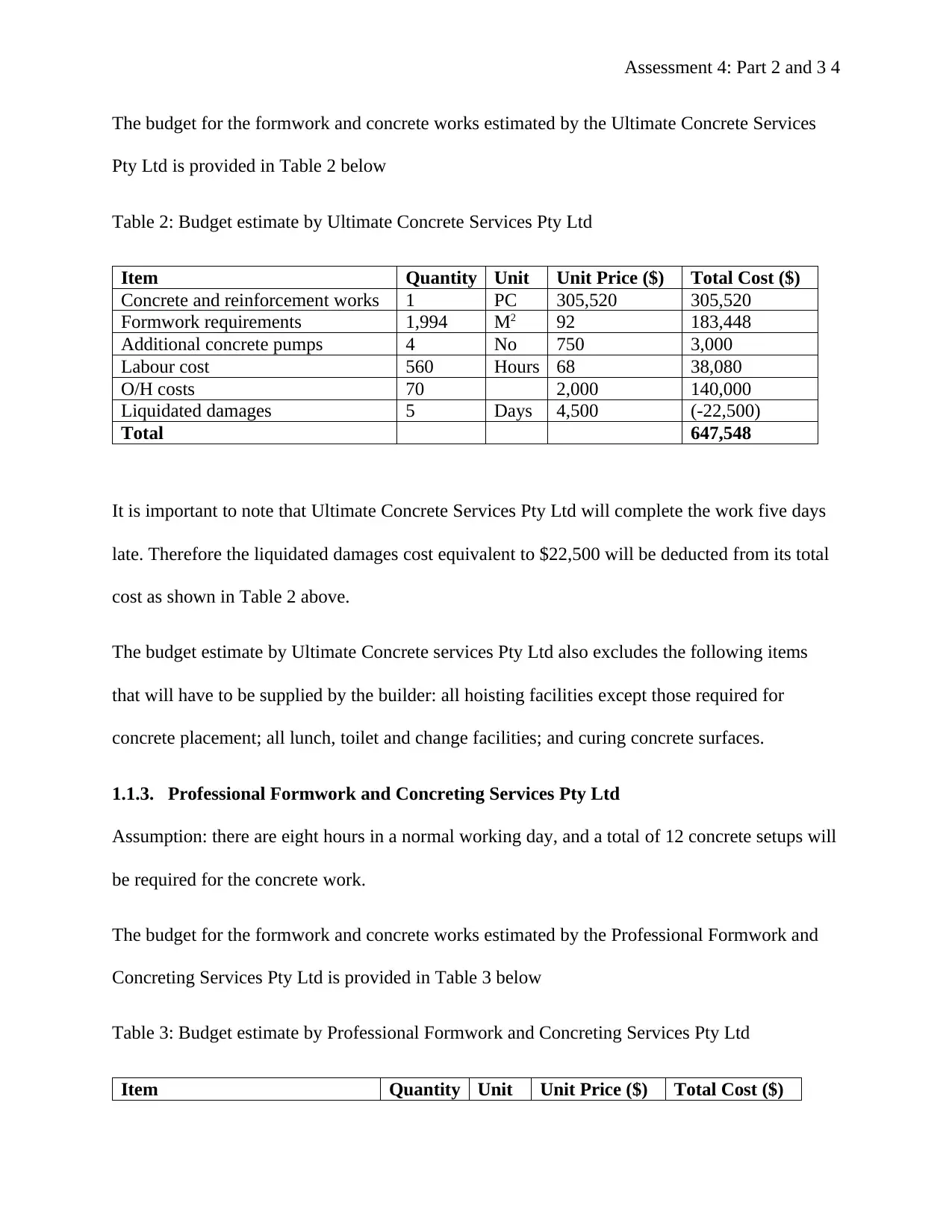
Assessment 4: Part 2 and 3 4
The budget for the formwork and concrete works estimated by the Ultimate Concrete Services
Pty Ltd is provided in Table 2 below
Table 2: Budget estimate by Ultimate Concrete Services Pty Ltd
Item Quantity Unit Unit Price ($) Total Cost ($)
Concrete and reinforcement works 1 PC 305,520 305,520
Formwork requirements 1,994 M2 92 183,448
Additional concrete pumps 4 No 750 3,000
Labour cost 560 Hours 68 38,080
O/H costs 70 2,000 140,000
Liquidated damages 5 Days 4,500 (-22,500)
Total 647,548
It is important to note that Ultimate Concrete Services Pty Ltd will complete the work five days
late. Therefore the liquidated damages cost equivalent to $22,500 will be deducted from its total
cost as shown in Table 2 above.
The budget estimate by Ultimate Concrete services Pty Ltd also excludes the following items
that will have to be supplied by the builder: all hoisting facilities except those required for
concrete placement; all lunch, toilet and change facilities; and curing concrete surfaces.
1.1.3. Professional Formwork and Concreting Services Pty Ltd
Assumption: there are eight hours in a normal working day, and a total of 12 concrete setups will
be required for the concrete work.
The budget for the formwork and concrete works estimated by the Professional Formwork and
Concreting Services Pty Ltd is provided in Table 3 below
Table 3: Budget estimate by Professional Formwork and Concreting Services Pty Ltd
Item Quantity Unit Unit Price ($) Total Cost ($)
The budget for the formwork and concrete works estimated by the Ultimate Concrete Services
Pty Ltd is provided in Table 2 below
Table 2: Budget estimate by Ultimate Concrete Services Pty Ltd
Item Quantity Unit Unit Price ($) Total Cost ($)
Concrete and reinforcement works 1 PC 305,520 305,520
Formwork requirements 1,994 M2 92 183,448
Additional concrete pumps 4 No 750 3,000
Labour cost 560 Hours 68 38,080
O/H costs 70 2,000 140,000
Liquidated damages 5 Days 4,500 (-22,500)
Total 647,548
It is important to note that Ultimate Concrete Services Pty Ltd will complete the work five days
late. Therefore the liquidated damages cost equivalent to $22,500 will be deducted from its total
cost as shown in Table 2 above.
The budget estimate by Ultimate Concrete services Pty Ltd also excludes the following items
that will have to be supplied by the builder: all hoisting facilities except those required for
concrete placement; all lunch, toilet and change facilities; and curing concrete surfaces.
1.1.3. Professional Formwork and Concreting Services Pty Ltd
Assumption: there are eight hours in a normal working day, and a total of 12 concrete setups will
be required for the concrete work.
The budget for the formwork and concrete works estimated by the Professional Formwork and
Concreting Services Pty Ltd is provided in Table 3 below
Table 3: Budget estimate by Professional Formwork and Concreting Services Pty Ltd
Item Quantity Unit Unit Price ($) Total Cost ($)
Paraphrase This Document
Need a fresh take? Get an instant paraphrase of this document with our AI Paraphraser
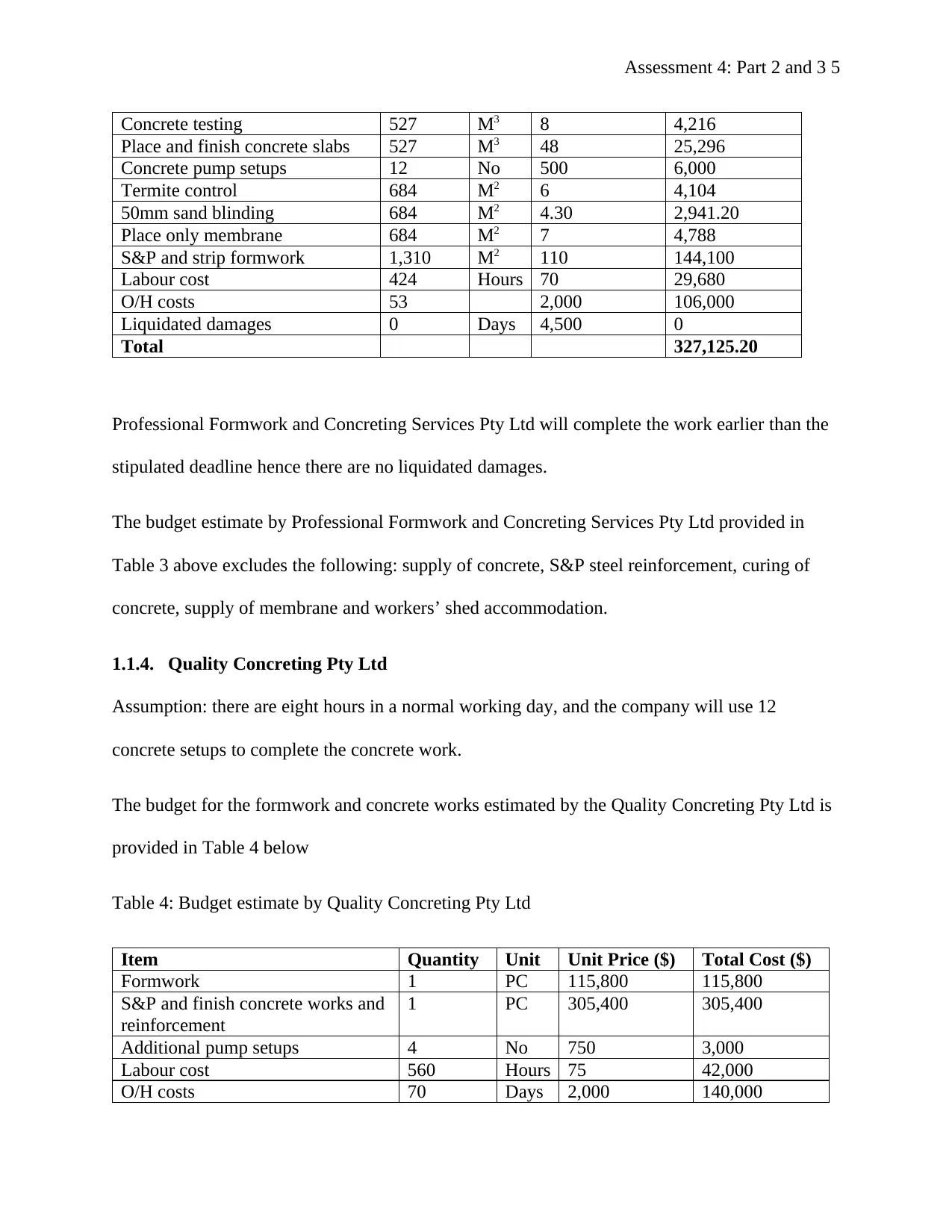
Assessment 4: Part 2 and 3 5
Concrete testing 527 M3 8 4,216
Place and finish concrete slabs 527 M3 48 25,296
Concrete pump setups 12 No 500 6,000
Termite control 684 M2 6 4,104
50mm sand blinding 684 M2 4.30 2,941.20
Place only membrane 684 M2 7 4,788
S&P and strip formwork 1,310 M2 110 144,100
Labour cost 424 Hours 70 29,680
O/H costs 53 2,000 106,000
Liquidated damages 0 Days 4,500 0
Total 327,125.20
Professional Formwork and Concreting Services Pty Ltd will complete the work earlier than the
stipulated deadline hence there are no liquidated damages.
The budget estimate by Professional Formwork and Concreting Services Pty Ltd provided in
Table 3 above excludes the following: supply of concrete, S&P steel reinforcement, curing of
concrete, supply of membrane and workers’ shed accommodation.
1.1.4. Quality Concreting Pty Ltd
Assumption: there are eight hours in a normal working day, and the company will use 12
concrete setups to complete the concrete work.
The budget for the formwork and concrete works estimated by the Quality Concreting Pty Ltd is
provided in Table 4 below
Table 4: Budget estimate by Quality Concreting Pty Ltd
Item Quantity Unit Unit Price ($) Total Cost ($)
Formwork 1 PC 115,800 115,800
S&P and finish concrete works and
reinforcement
1 PC 305,400 305,400
Additional pump setups 4 No 750 3,000
Labour cost 560 Hours 75 42,000
O/H costs 70 Days 2,000 140,000
Concrete testing 527 M3 8 4,216
Place and finish concrete slabs 527 M3 48 25,296
Concrete pump setups 12 No 500 6,000
Termite control 684 M2 6 4,104
50mm sand blinding 684 M2 4.30 2,941.20
Place only membrane 684 M2 7 4,788
S&P and strip formwork 1,310 M2 110 144,100
Labour cost 424 Hours 70 29,680
O/H costs 53 2,000 106,000
Liquidated damages 0 Days 4,500 0
Total 327,125.20
Professional Formwork and Concreting Services Pty Ltd will complete the work earlier than the
stipulated deadline hence there are no liquidated damages.
The budget estimate by Professional Formwork and Concreting Services Pty Ltd provided in
Table 3 above excludes the following: supply of concrete, S&P steel reinforcement, curing of
concrete, supply of membrane and workers’ shed accommodation.
1.1.4. Quality Concreting Pty Ltd
Assumption: there are eight hours in a normal working day, and the company will use 12
concrete setups to complete the concrete work.
The budget for the formwork and concrete works estimated by the Quality Concreting Pty Ltd is
provided in Table 4 below
Table 4: Budget estimate by Quality Concreting Pty Ltd
Item Quantity Unit Unit Price ($) Total Cost ($)
Formwork 1 PC 115,800 115,800
S&P and finish concrete works and
reinforcement
1 PC 305,400 305,400
Additional pump setups 4 No 750 3,000
Labour cost 560 Hours 75 42,000
O/H costs 70 Days 2,000 140,000
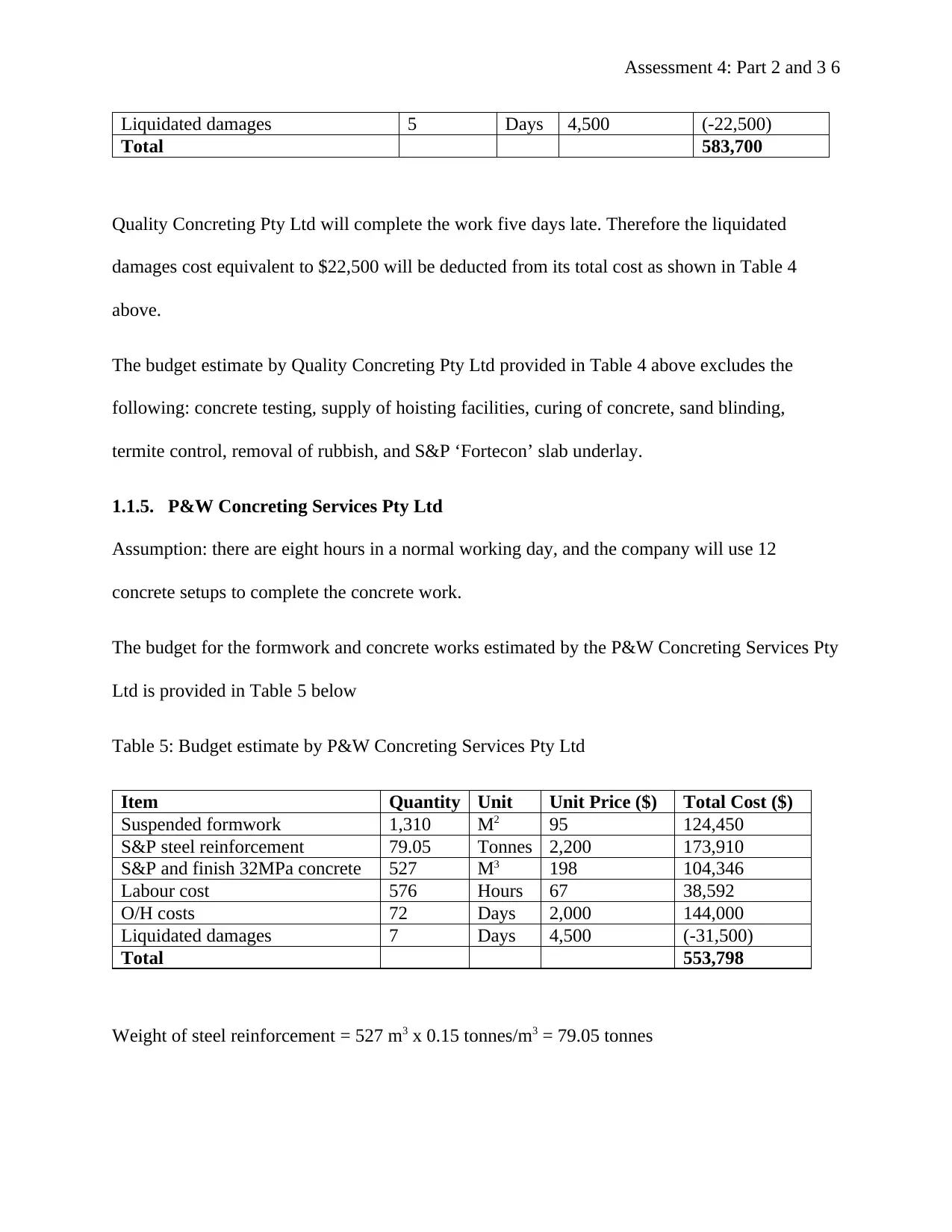
Assessment 4: Part 2 and 3 6
Liquidated damages 5 Days 4,500 (-22,500)
Total 583,700
Quality Concreting Pty Ltd will complete the work five days late. Therefore the liquidated
damages cost equivalent to $22,500 will be deducted from its total cost as shown in Table 4
above.
The budget estimate by Quality Concreting Pty Ltd provided in Table 4 above excludes the
following: concrete testing, supply of hoisting facilities, curing of concrete, sand blinding,
termite control, removal of rubbish, and S&P ‘Fortecon’ slab underlay.
1.1.5. P&W Concreting Services Pty Ltd
Assumption: there are eight hours in a normal working day, and the company will use 12
concrete setups to complete the concrete work.
The budget for the formwork and concrete works estimated by the P&W Concreting Services Pty
Ltd is provided in Table 5 below
Table 5: Budget estimate by P&W Concreting Services Pty Ltd
Item Quantity Unit Unit Price ($) Total Cost ($)
Suspended formwork 1,310 M2 95 124,450
S&P steel reinforcement 79.05 Tonnes 2,200 173,910
S&P and finish 32MPa concrete 527 M3 198 104,346
Labour cost 576 Hours 67 38,592
O/H costs 72 Days 2,000 144,000
Liquidated damages 7 Days 4,500 (-31,500)
Total 553,798
Weight of steel reinforcement = 527 m3 x 0.15 tonnes/m3 = 79.05 tonnes
Liquidated damages 5 Days 4,500 (-22,500)
Total 583,700
Quality Concreting Pty Ltd will complete the work five days late. Therefore the liquidated
damages cost equivalent to $22,500 will be deducted from its total cost as shown in Table 4
above.
The budget estimate by Quality Concreting Pty Ltd provided in Table 4 above excludes the
following: concrete testing, supply of hoisting facilities, curing of concrete, sand blinding,
termite control, removal of rubbish, and S&P ‘Fortecon’ slab underlay.
1.1.5. P&W Concreting Services Pty Ltd
Assumption: there are eight hours in a normal working day, and the company will use 12
concrete setups to complete the concrete work.
The budget for the formwork and concrete works estimated by the P&W Concreting Services Pty
Ltd is provided in Table 5 below
Table 5: Budget estimate by P&W Concreting Services Pty Ltd
Item Quantity Unit Unit Price ($) Total Cost ($)
Suspended formwork 1,310 M2 95 124,450
S&P steel reinforcement 79.05 Tonnes 2,200 173,910
S&P and finish 32MPa concrete 527 M3 198 104,346
Labour cost 576 Hours 67 38,592
O/H costs 72 Days 2,000 144,000
Liquidated damages 7 Days 4,500 (-31,500)
Total 553,798
Weight of steel reinforcement = 527 m3 x 0.15 tonnes/m3 = 79.05 tonnes
⊘ This is a preview!⊘
Do you want full access?
Subscribe today to unlock all pages.

Trusted by 1+ million students worldwide
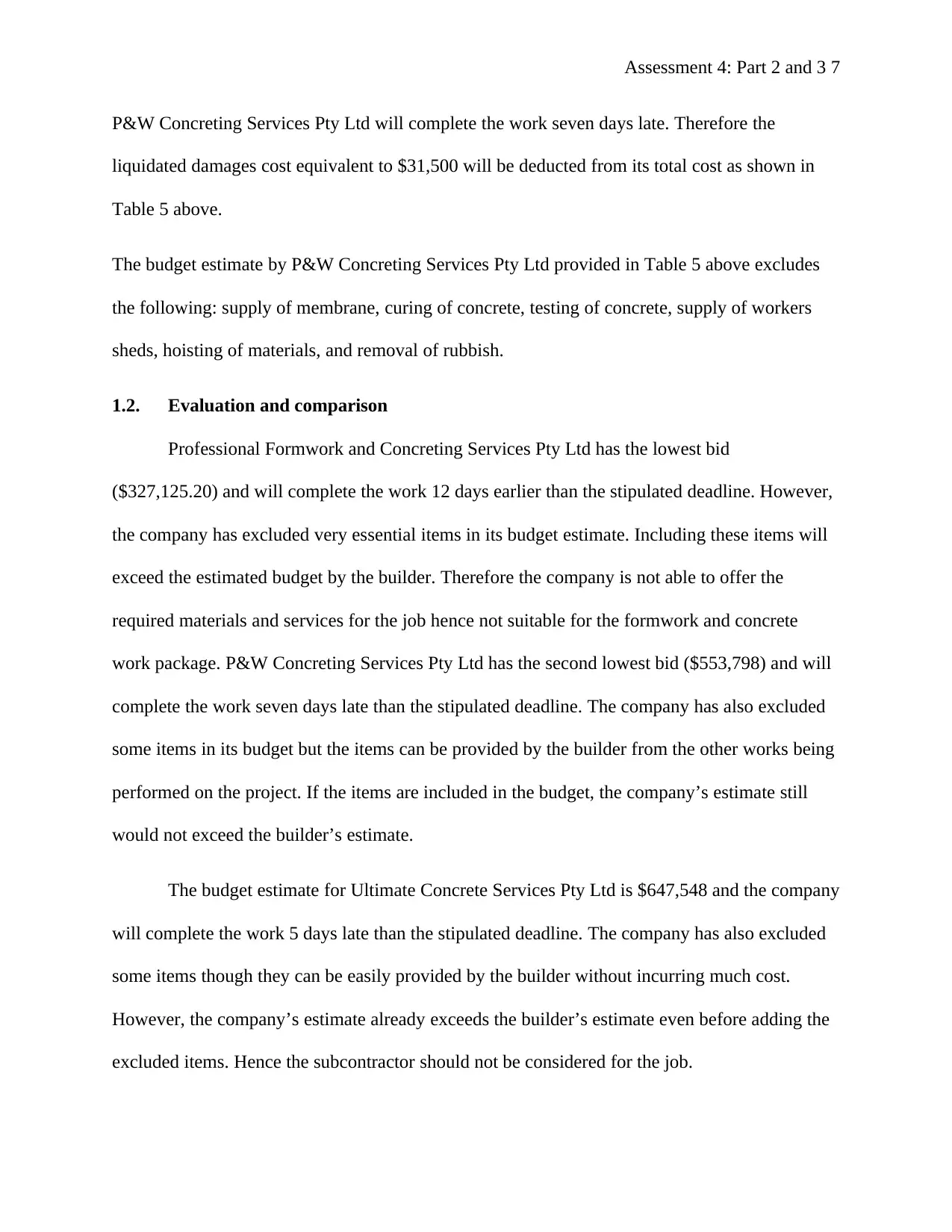
Assessment 4: Part 2 and 3 7
P&W Concreting Services Pty Ltd will complete the work seven days late. Therefore the
liquidated damages cost equivalent to $31,500 will be deducted from its total cost as shown in
Table 5 above.
The budget estimate by P&W Concreting Services Pty Ltd provided in Table 5 above excludes
the following: supply of membrane, curing of concrete, testing of concrete, supply of workers
sheds, hoisting of materials, and removal of rubbish.
1.2. Evaluation and comparison
Professional Formwork and Concreting Services Pty Ltd has the lowest bid
($327,125.20) and will complete the work 12 days earlier than the stipulated deadline. However,
the company has excluded very essential items in its budget estimate. Including these items will
exceed the estimated budget by the builder. Therefore the company is not able to offer the
required materials and services for the job hence not suitable for the formwork and concrete
work package. P&W Concreting Services Pty Ltd has the second lowest bid ($553,798) and will
complete the work seven days late than the stipulated deadline. The company has also excluded
some items in its budget but the items can be provided by the builder from the other works being
performed on the project. If the items are included in the budget, the company’s estimate still
would not exceed the builder’s estimate.
The budget estimate for Ultimate Concrete Services Pty Ltd is $647,548 and the company
will complete the work 5 days late than the stipulated deadline. The company has also excluded
some items though they can be easily provided by the builder without incurring much cost.
However, the company’s estimate already exceeds the builder’s estimate even before adding the
excluded items. Hence the subcontractor should not be considered for the job.
P&W Concreting Services Pty Ltd will complete the work seven days late. Therefore the
liquidated damages cost equivalent to $31,500 will be deducted from its total cost as shown in
Table 5 above.
The budget estimate by P&W Concreting Services Pty Ltd provided in Table 5 above excludes
the following: supply of membrane, curing of concrete, testing of concrete, supply of workers
sheds, hoisting of materials, and removal of rubbish.
1.2. Evaluation and comparison
Professional Formwork and Concreting Services Pty Ltd has the lowest bid
($327,125.20) and will complete the work 12 days earlier than the stipulated deadline. However,
the company has excluded very essential items in its budget estimate. Including these items will
exceed the estimated budget by the builder. Therefore the company is not able to offer the
required materials and services for the job hence not suitable for the formwork and concrete
work package. P&W Concreting Services Pty Ltd has the second lowest bid ($553,798) and will
complete the work seven days late than the stipulated deadline. The company has also excluded
some items in its budget but the items can be provided by the builder from the other works being
performed on the project. If the items are included in the budget, the company’s estimate still
would not exceed the builder’s estimate.
The budget estimate for Ultimate Concrete Services Pty Ltd is $647,548 and the company
will complete the work 5 days late than the stipulated deadline. The company has also excluded
some items though they can be easily provided by the builder without incurring much cost.
However, the company’s estimate already exceeds the builder’s estimate even before adding the
excluded items. Hence the subcontractor should not be considered for the job.
Paraphrase This Document
Need a fresh take? Get an instant paraphrase of this document with our AI Paraphraser
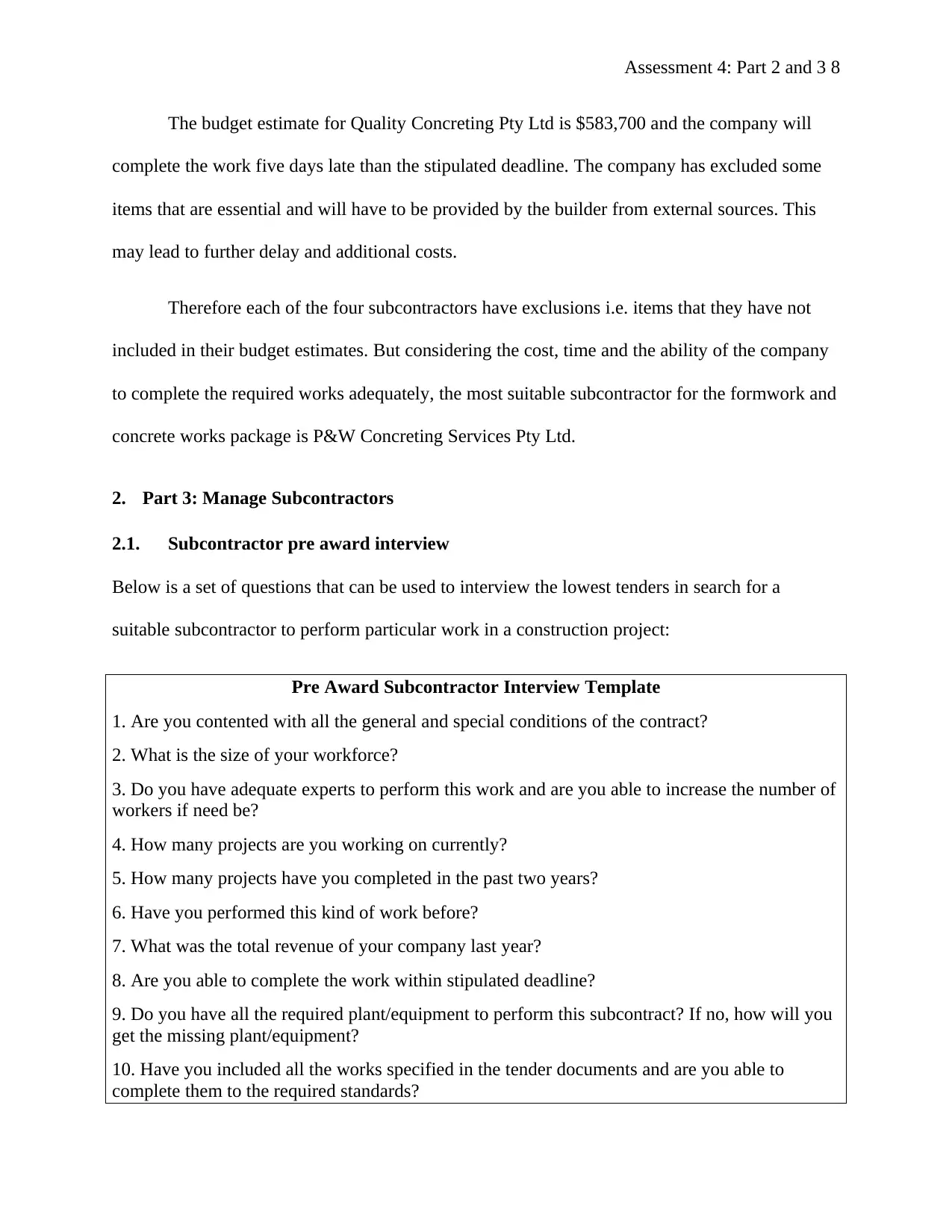
Assessment 4: Part 2 and 3 8
The budget estimate for Quality Concreting Pty Ltd is $583,700 and the company will
complete the work five days late than the stipulated deadline. The company has excluded some
items that are essential and will have to be provided by the builder from external sources. This
may lead to further delay and additional costs.
Therefore each of the four subcontractors have exclusions i.e. items that they have not
included in their budget estimates. But considering the cost, time and the ability of the company
to complete the required works adequately, the most suitable subcontractor for the formwork and
concrete works package is P&W Concreting Services Pty Ltd.
2. Part 3: Manage Subcontractors
2.1. Subcontractor pre award interview
Below is a set of questions that can be used to interview the lowest tenders in search for a
suitable subcontractor to perform particular work in a construction project:
Pre Award Subcontractor Interview Template
1. Are you contented with all the general and special conditions of the contract?
2. What is the size of your workforce?
3. Do you have adequate experts to perform this work and are you able to increase the number of
workers if need be?
4. How many projects are you working on currently?
5. How many projects have you completed in the past two years?
6. Have you performed this kind of work before?
7. What was the total revenue of your company last year?
8. Are you able to complete the work within stipulated deadline?
9. Do you have all the required plant/equipment to perform this subcontract? If no, how will you
get the missing plant/equipment?
10. Have you included all the works specified in the tender documents and are you able to
complete them to the required standards?
The budget estimate for Quality Concreting Pty Ltd is $583,700 and the company will
complete the work five days late than the stipulated deadline. The company has excluded some
items that are essential and will have to be provided by the builder from external sources. This
may lead to further delay and additional costs.
Therefore each of the four subcontractors have exclusions i.e. items that they have not
included in their budget estimates. But considering the cost, time and the ability of the company
to complete the required works adequately, the most suitable subcontractor for the formwork and
concrete works package is P&W Concreting Services Pty Ltd.
2. Part 3: Manage Subcontractors
2.1. Subcontractor pre award interview
Below is a set of questions that can be used to interview the lowest tenders in search for a
suitable subcontractor to perform particular work in a construction project:
Pre Award Subcontractor Interview Template
1. Are you contented with all the general and special conditions of the contract?
2. What is the size of your workforce?
3. Do you have adequate experts to perform this work and are you able to increase the number of
workers if need be?
4. How many projects are you working on currently?
5. How many projects have you completed in the past two years?
6. Have you performed this kind of work before?
7. What was the total revenue of your company last year?
8. Are you able to complete the work within stipulated deadline?
9. Do you have all the required plant/equipment to perform this subcontract? If no, how will you
get the missing plant/equipment?
10. Have you included all the works specified in the tender documents and are you able to
complete them to the required standards?
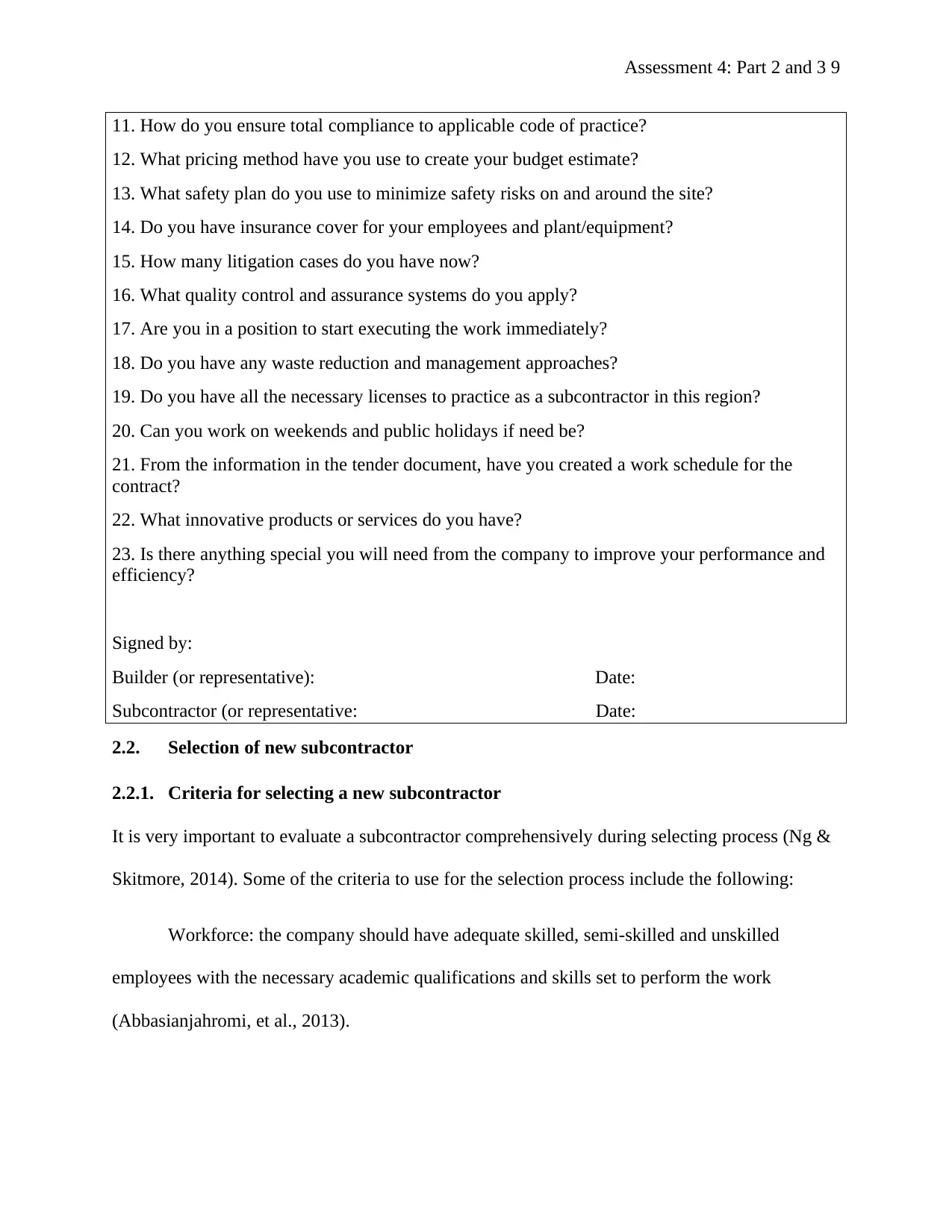
Assessment 4: Part 2 and 3 9
11. How do you ensure total compliance to applicable code of practice?
12. What pricing method have you use to create your budget estimate?
13. What safety plan do you use to minimize safety risks on and around the site?
14. Do you have insurance cover for your employees and plant/equipment?
15. How many litigation cases do you have now?
16. What quality control and assurance systems do you apply?
17. Are you in a position to start executing the work immediately?
18. Do you have any waste reduction and management approaches?
19. Do you have all the necessary licenses to practice as a subcontractor in this region?
20. Can you work on weekends and public holidays if need be?
21. From the information in the tender document, have you created a work schedule for the
contract?
22. What innovative products or services do you have?
23. Is there anything special you will need from the company to improve your performance and
efficiency?
Signed by:
Builder (or representative): Date:
Subcontractor (or representative: Date:
2.2. Selection of new subcontractor
2.2.1. Criteria for selecting a new subcontractor
It is very important to evaluate a subcontractor comprehensively during selecting process (Ng &
Skitmore, 2014). Some of the criteria to use for the selection process include the following:
Workforce: the company should have adequate skilled, semi-skilled and unskilled
employees with the necessary academic qualifications and skills set to perform the work
(Abbasianjahromi, et al., 2013).
11. How do you ensure total compliance to applicable code of practice?
12. What pricing method have you use to create your budget estimate?
13. What safety plan do you use to minimize safety risks on and around the site?
14. Do you have insurance cover for your employees and plant/equipment?
15. How many litigation cases do you have now?
16. What quality control and assurance systems do you apply?
17. Are you in a position to start executing the work immediately?
18. Do you have any waste reduction and management approaches?
19. Do you have all the necessary licenses to practice as a subcontractor in this region?
20. Can you work on weekends and public holidays if need be?
21. From the information in the tender document, have you created a work schedule for the
contract?
22. What innovative products or services do you have?
23. Is there anything special you will need from the company to improve your performance and
efficiency?
Signed by:
Builder (or representative): Date:
Subcontractor (or representative: Date:
2.2. Selection of new subcontractor
2.2.1. Criteria for selecting a new subcontractor
It is very important to evaluate a subcontractor comprehensively during selecting process (Ng &
Skitmore, 2014). Some of the criteria to use for the selection process include the following:
Workforce: the company should have adequate skilled, semi-skilled and unskilled
employees with the necessary academic qualifications and skills set to perform the work
(Abbasianjahromi, et al., 2013).
⊘ This is a preview!⊘
Do you want full access?
Subscribe today to unlock all pages.

Trusted by 1+ million students worldwide
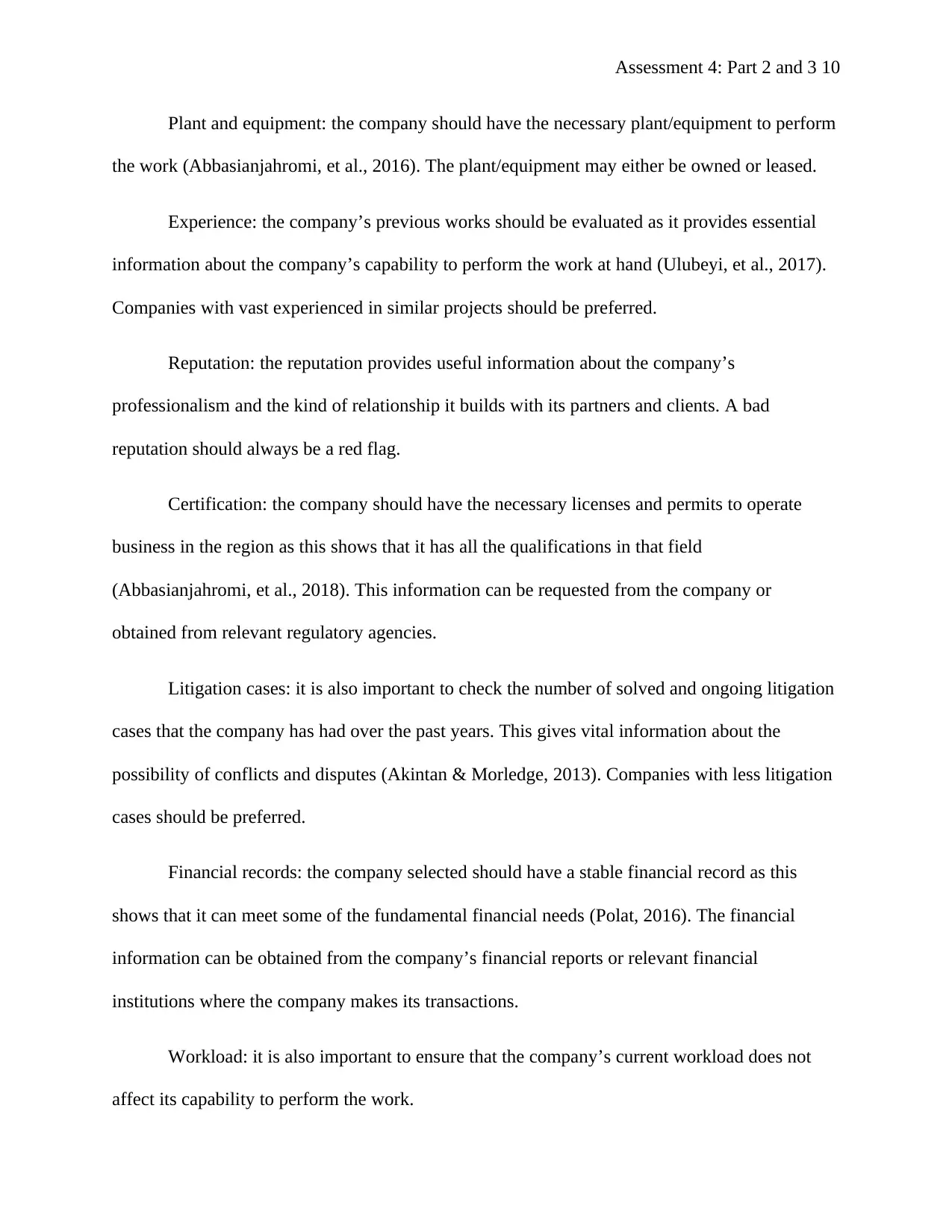
Assessment 4: Part 2 and 3 10
Plant and equipment: the company should have the necessary plant/equipment to perform
the work (Abbasianjahromi, et al., 2016). The plant/equipment may either be owned or leased.
Experience: the company’s previous works should be evaluated as it provides essential
information about the company’s capability to perform the work at hand (Ulubeyi, et al., 2017).
Companies with vast experienced in similar projects should be preferred.
Reputation: the reputation provides useful information about the company’s
professionalism and the kind of relationship it builds with its partners and clients. A bad
reputation should always be a red flag.
Certification: the company should have the necessary licenses and permits to operate
business in the region as this shows that it has all the qualifications in that field
(Abbasianjahromi, et al., 2018). This information can be requested from the company or
obtained from relevant regulatory agencies.
Litigation cases: it is also important to check the number of solved and ongoing litigation
cases that the company has had over the past years. This gives vital information about the
possibility of conflicts and disputes (Akintan & Morledge, 2013). Companies with less litigation
cases should be preferred.
Financial records: the company selected should have a stable financial record as this
shows that it can meet some of the fundamental financial needs (Polat, 2016). The financial
information can be obtained from the company’s financial reports or relevant financial
institutions where the company makes its transactions.
Workload: it is also important to ensure that the company’s current workload does not
affect its capability to perform the work.
Plant and equipment: the company should have the necessary plant/equipment to perform
the work (Abbasianjahromi, et al., 2016). The plant/equipment may either be owned or leased.
Experience: the company’s previous works should be evaluated as it provides essential
information about the company’s capability to perform the work at hand (Ulubeyi, et al., 2017).
Companies with vast experienced in similar projects should be preferred.
Reputation: the reputation provides useful information about the company’s
professionalism and the kind of relationship it builds with its partners and clients. A bad
reputation should always be a red flag.
Certification: the company should have the necessary licenses and permits to operate
business in the region as this shows that it has all the qualifications in that field
(Abbasianjahromi, et al., 2018). This information can be requested from the company or
obtained from relevant regulatory agencies.
Litigation cases: it is also important to check the number of solved and ongoing litigation
cases that the company has had over the past years. This gives vital information about the
possibility of conflicts and disputes (Akintan & Morledge, 2013). Companies with less litigation
cases should be preferred.
Financial records: the company selected should have a stable financial record as this
shows that it can meet some of the fundamental financial needs (Polat, 2016). The financial
information can be obtained from the company’s financial reports or relevant financial
institutions where the company makes its transactions.
Workload: it is also important to ensure that the company’s current workload does not
affect its capability to perform the work.
Paraphrase This Document
Need a fresh take? Get an instant paraphrase of this document with our AI Paraphraser
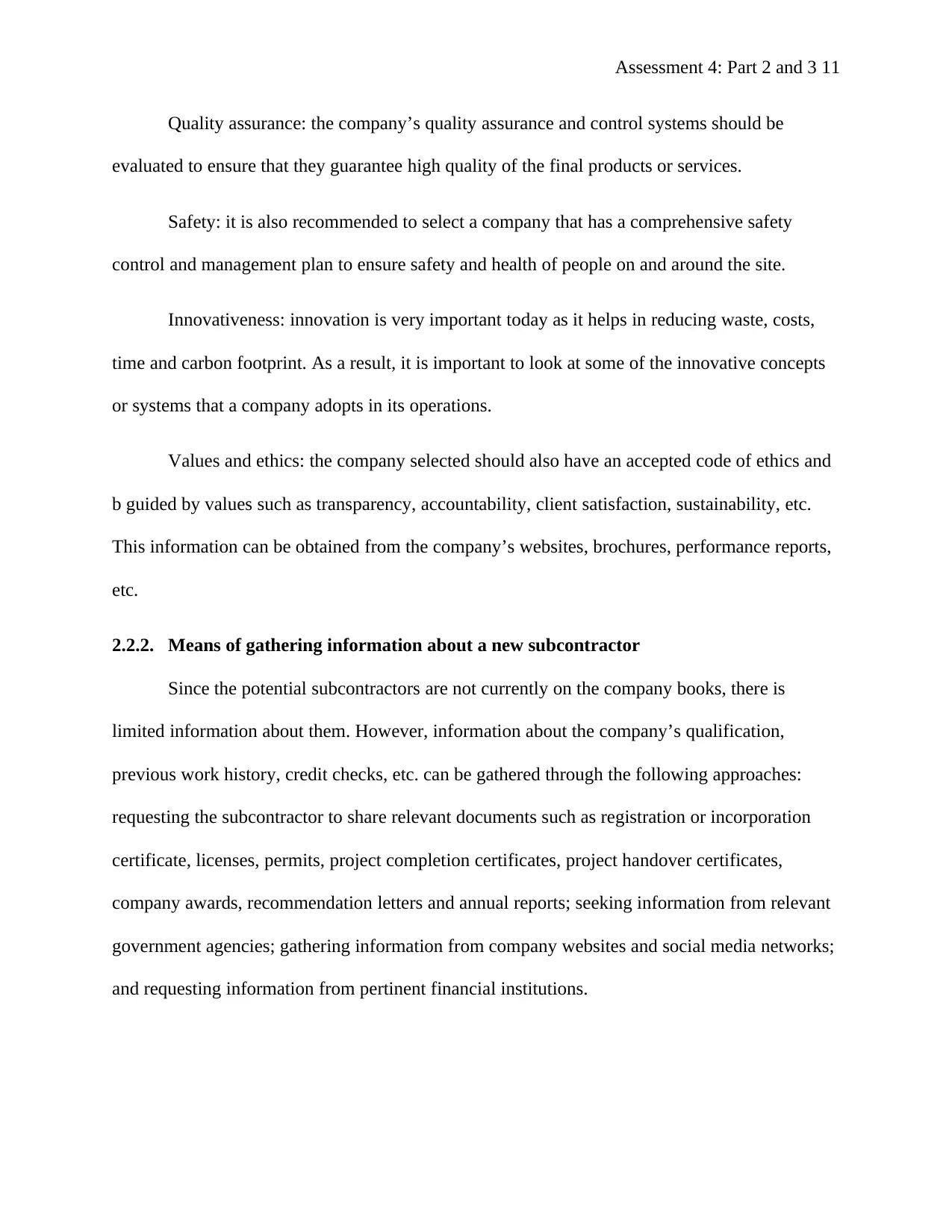
Assessment 4: Part 2 and 3 11
Quality assurance: the company’s quality assurance and control systems should be
evaluated to ensure that they guarantee high quality of the final products or services.
Safety: it is also recommended to select a company that has a comprehensive safety
control and management plan to ensure safety and health of people on and around the site.
Innovativeness: innovation is very important today as it helps in reducing waste, costs,
time and carbon footprint. As a result, it is important to look at some of the innovative concepts
or systems that a company adopts in its operations.
Values and ethics: the company selected should also have an accepted code of ethics and
b guided by values such as transparency, accountability, client satisfaction, sustainability, etc.
This information can be obtained from the company’s websites, brochures, performance reports,
etc.
2.2.2. Means of gathering information about a new subcontractor
Since the potential subcontractors are not currently on the company books, there is
limited information about them. However, information about the company’s qualification,
previous work history, credit checks, etc. can be gathered through the following approaches:
requesting the subcontractor to share relevant documents such as registration or incorporation
certificate, licenses, permits, project completion certificates, project handover certificates,
company awards, recommendation letters and annual reports; seeking information from relevant
government agencies; gathering information from company websites and social media networks;
and requesting information from pertinent financial institutions.
Quality assurance: the company’s quality assurance and control systems should be
evaluated to ensure that they guarantee high quality of the final products or services.
Safety: it is also recommended to select a company that has a comprehensive safety
control and management plan to ensure safety and health of people on and around the site.
Innovativeness: innovation is very important today as it helps in reducing waste, costs,
time and carbon footprint. As a result, it is important to look at some of the innovative concepts
or systems that a company adopts in its operations.
Values and ethics: the company selected should also have an accepted code of ethics and
b guided by values such as transparency, accountability, client satisfaction, sustainability, etc.
This information can be obtained from the company’s websites, brochures, performance reports,
etc.
2.2.2. Means of gathering information about a new subcontractor
Since the potential subcontractors are not currently on the company books, there is
limited information about them. However, information about the company’s qualification,
previous work history, credit checks, etc. can be gathered through the following approaches:
requesting the subcontractor to share relevant documents such as registration or incorporation
certificate, licenses, permits, project completion certificates, project handover certificates,
company awards, recommendation letters and annual reports; seeking information from relevant
government agencies; gathering information from company websites and social media networks;
and requesting information from pertinent financial institutions.
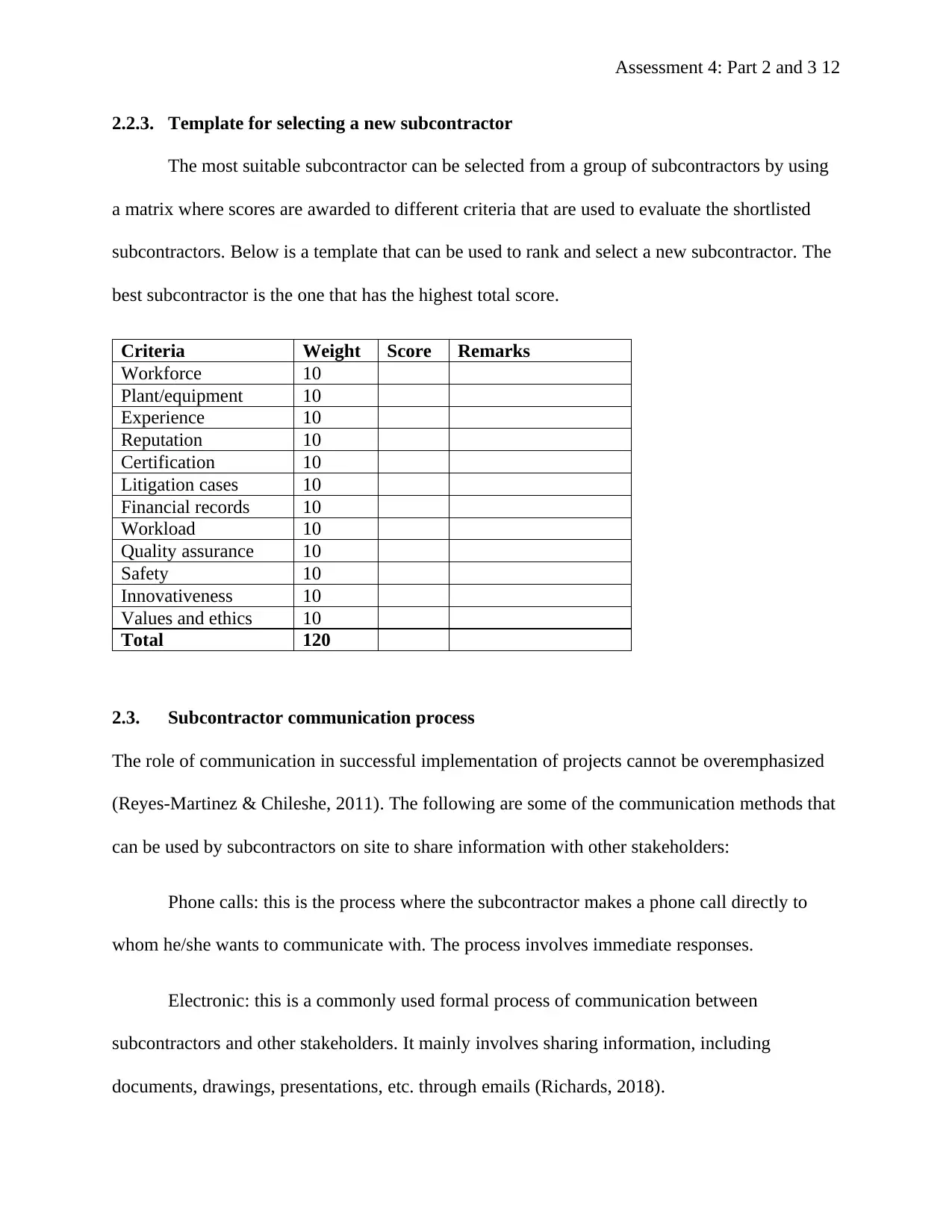
Assessment 4: Part 2 and 3 12
2.2.3. Template for selecting a new subcontractor
The most suitable subcontractor can be selected from a group of subcontractors by using
a matrix where scores are awarded to different criteria that are used to evaluate the shortlisted
subcontractors. Below is a template that can be used to rank and select a new subcontractor. The
best subcontractor is the one that has the highest total score.
Criteria Weight Score Remarks
Workforce 10
Plant/equipment 10
Experience 10
Reputation 10
Certification 10
Litigation cases 10
Financial records 10
Workload 10
Quality assurance 10
Safety 10
Innovativeness 10
Values and ethics 10
Total 120
2.3. Subcontractor communication process
The role of communication in successful implementation of projects cannot be overemphasized
(Reyes-Martinez & Chileshe, 2011). The following are some of the communication methods that
can be used by subcontractors on site to share information with other stakeholders:
Phone calls: this is the process where the subcontractor makes a phone call directly to
whom he/she wants to communicate with. The process involves immediate responses.
Electronic: this is a commonly used formal process of communication between
subcontractors and other stakeholders. It mainly involves sharing information, including
documents, drawings, presentations, etc. through emails (Richards, 2018).
2.2.3. Template for selecting a new subcontractor
The most suitable subcontractor can be selected from a group of subcontractors by using
a matrix where scores are awarded to different criteria that are used to evaluate the shortlisted
subcontractors. Below is a template that can be used to rank and select a new subcontractor. The
best subcontractor is the one that has the highest total score.
Criteria Weight Score Remarks
Workforce 10
Plant/equipment 10
Experience 10
Reputation 10
Certification 10
Litigation cases 10
Financial records 10
Workload 10
Quality assurance 10
Safety 10
Innovativeness 10
Values and ethics 10
Total 120
2.3. Subcontractor communication process
The role of communication in successful implementation of projects cannot be overemphasized
(Reyes-Martinez & Chileshe, 2011). The following are some of the communication methods that
can be used by subcontractors on site to share information with other stakeholders:
Phone calls: this is the process where the subcontractor makes a phone call directly to
whom he/she wants to communicate with. The process involves immediate responses.
Electronic: this is a commonly used formal process of communication between
subcontractors and other stakeholders. It mainly involves sharing information, including
documents, drawings, presentations, etc. through emails (Richards, 2018).
⊘ This is a preview!⊘
Do you want full access?
Subscribe today to unlock all pages.

Trusted by 1+ million students worldwide
1 out of 20
Related Documents
Your All-in-One AI-Powered Toolkit for Academic Success.
+13062052269
info@desklib.com
Available 24*7 on WhatsApp / Email
![[object Object]](/_next/static/media/star-bottom.7253800d.svg)
Unlock your academic potential
Copyright © 2020–2025 A2Z Services. All Rights Reserved. Developed and managed by ZUCOL.




